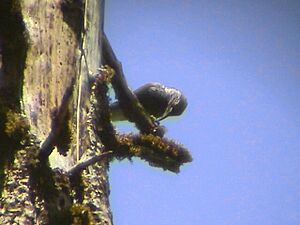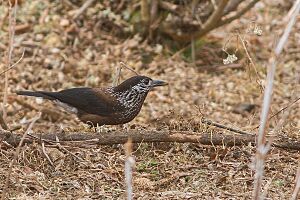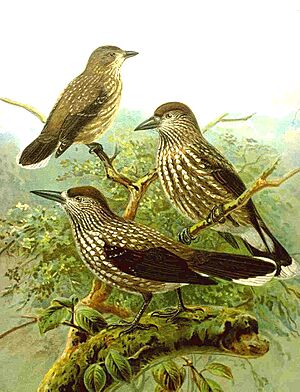Spotted nutcracker facts for kids
Quick facts for kids Spotted nutcracker |
|
|---|---|
 |
|
| Near the Morskie Oko, Poland | |
| Conservation status | |
| Scientific classification | |
| Genus: |
Nucifraga
|
| Species: |
caryocatactes
|
 |
|
| Synonyms | |
|
|
The spotted nutcracker (Nucifraga caryocatactes) is a cool bird that looks a bit like a Eurasian jay, but it's a little bigger. It has a larger beak and a smoother head without a feathery crest. Most of its body is chocolate brown with clear white spots and stripes. Its wings and upper tail are almost black with a shiny greenish-blue color.
The spotted nutcracker is one of three types of nutcrackers. Another type, the Kashmir nutcracker, used to be thought of as a subspecies of the spotted nutcracker. The third type, Clark's nutcracker, lives in western North America.
Contents
About the Spotted Nutcracker
The spotted nutcracker was first described by a famous scientist named Carl Linnaeus in 1758. Its scientific name, Nucifraga caryocatactes, is a bit like saying "nut-breaker" twice! Nucifraga comes from Latin words meaning "nut" and "to shatter." Caryocatactes comes from Greek words meaning "nut" and "to shatter."
The English name "nutcracker" first appeared in 1693. It came from the German name Nußknacker, which also means "nut-cracker."
Different Types of Nutcrackers
There are nine different types, or subspecies, of the spotted nutcracker. These are like different groups within the same species that live in various places.
- caryocatactes: Found from Scandinavia to northern and eastern Europe.
- macrorhynchos: Lives in northern and northeastern Asia.
- rothschildi: Found in the Tian Shan mountains in Kazakhstan and China.
- japonica: Lives in Japan.
- owstoni: Found in Taiwan.
- interdicta: Lives in the mountains of northern China.
- hemispila: Found in the Himalayas.
- macella: Lives from the eastern Himalayas to southwest China.
- yunnanensis: Found in southeast China.
Some scientists think that these types could actually be split into two separate species. This is because the northern groups look quite different from the southern groups.
What They Look Like
The spotted nutcracker is a dark brown bird with wide wings and a short tail. Its body is a medium to dark chocolate brown. It has many white spots on its face, neck, back, and belly. It also has a white spot near its beak and a white ring around its eye. Its cap, or the top of its head, is dark blackish-brown. Its wings are dark blackish with a shiny greenish-blue color. The area under its tail is all white, and its tail is dark with white corners.
When it flies, you can easily see its wide wings, white belly, and short tail. Its flight looks like it's going up and down. Its black beak is thin, quite long, and very pointed. The size of the beak can be different depending on where the bird lives. Its eyes, legs, and feet are black.
Nutcrackers are about 32–38 centimeters (12.6–15 inches) long. Their wings can spread out from 49–53 centimeters (19–21 inches).
Their voice sounds like the Eurasian jay, and it's loud and harsh. People describe it as kraak-kraak-kraak-kraak.
Behaviour
Feeding Habits

The most important food for the spotted nutcracker is the seeds, or pine nuts, from different types of pine trees. They especially like the large seeds from cold-climate pine trees like the Swiss pine and Siberian pine. In some areas where these pines don't grow, they eat seeds from spruce trees and hazel nuts. Nutcrackers that eat hazelnuts have thicker beaks to crack the hard shells. If a shell is too hard, they hold the nut with their feet and peck at it with their beak like a chisel.
Nutcrackers have a special tongue! The tip of their tongue splits into two long, pointed parts that are hard like nails. This helps them hold and open conifer seeds.
They always store extra seeds for later. This is super important because they help plant new trees! They are known for helping the Swiss pine trees grow back in large areas of the Alps that people had cleared.
They also eat different insects. Sometimes, they eat small birds, their eggs, or baby birds. They also eat small rodents and other small animals. They love to dig up bumble bee and wasp nests to get to the grubs inside.
Reproduction and Life Cycle
Nutcracker pairs usually stay together for their whole lives. Their home area can be quite large, about 20 to 30 acres. They always build their nests early in the year. This helps them use the pine nuts they stored from the autumn before.
The nest is usually built high up in a conifer tree, often on the sunny side. They usually lay 2 to 4 eggs. Both parents take turns sitting on the eggs for about 18 days. Once the chicks hatch, both parents feed them. The young birds are ready to fly after about 23 days. They stay with their parents for many months to learn how to find and store food. This skill is very important for them to survive in their tough environment.
Where They Live
The spotted nutcracker lives across a huge area from Scandinavia all the way across northern Europe, Siberia, and into eastern Asia, including Japan. They live in the massive taiga conifer forests in the north.
There are also three other groups of nutcrackers that live in mountain conifer forests further south. One group is in the mountains of central and southeast Europe, like the Alps. Another is in the western Himalayas. The third is in western China.
This bird species lives in a very large area, covering over 10,000,000 square kilometers (about 3.8 million square miles) worldwide. There are also many of them, with an estimated 800,000 to 1,700,000 birds in Europe alone.
Spotted nutcrackers usually don't migrate, meaning they don't fly to different places for seasons. But sometimes, if there aren't enough pine cones for food, they will fly to new areas. For example, in 1968, over 300 nutcrackers visited Britain. This was part of a bigger movement into western Europe, probably because of very cold weather in Siberia.






